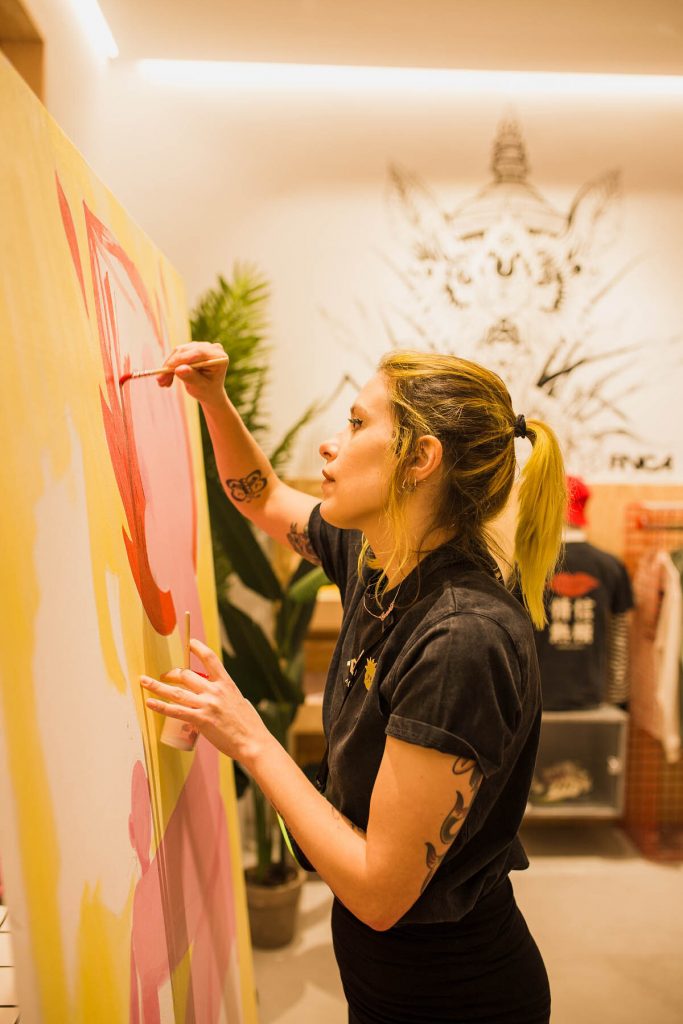
Genie Espinosa’s squishy bodies and bright colours have become a winning combination for the Spanish comics artist and illustrator. With a background in marketing, it’s perhaps no surprise that she has a good eye for designing illustrations for posters and editorials. Her personal work and comics are no less fun.
In her comics, Espinosa often displays more of an interest in lines and traditional cartooning methods, while her “personal” work (illustrations for Tees and murals) mostly forego ink outlines, instead relying on bouncy shapes and experiments with sharply contrasting colors. No matter what the project is, Espinosa’s core themes often recur throughout: play, sexuality, body forms, fears, ferocity, self-esteem, and uncertainty.
Most recently, she has edited and published two issues of an all-female zine, Raras and Muy Raras (meaning “Weirdos” and “Very Weird”, in the feminine). As she discusses in the following Q&A, the zine’s name comes from personal experiences. Raras has come out at a time when the country’s alternative scene is going through something of a renaissance. Over its two issues, Espinosa has created room for some of Spain’s most exciting cartoonists and illustrators, including Ignatz nominee Ana Galvañ and Instagram sensation Flavita Banana.
We caught up with Espinosa to talk about her transition into cartooning full time, the impetus behind her recent publishing venture, and experiences as an entrepreneur making a living off of her creativity.
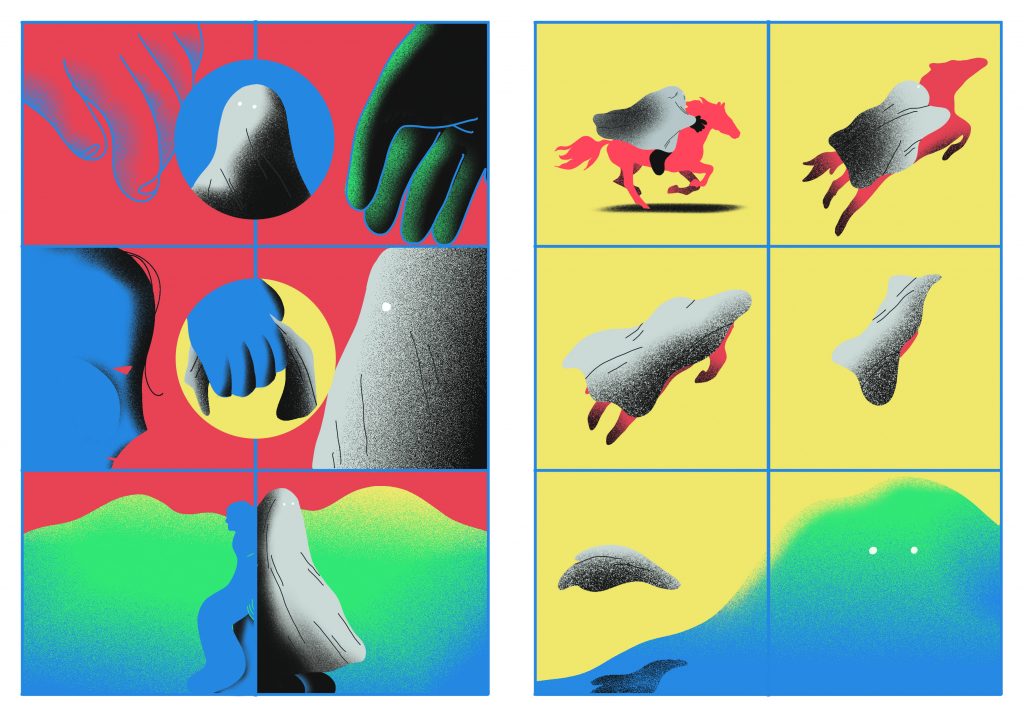
Interview conducted in Spanish. Translation and additional questions by Isabel Palomar.
When did you get into illustration, were you reading comics when you were growing up? In general, what inspired you?
I was twenty-eight when I stepped into this world. At the time, I was working as the head of the marketing department of a company in Barcelona, and I realized I had one last chance at trying to make a living as an illustrator (at that time I felt I was too old to do it). It was a very strong feeling, like an intense need to fulfill my professional self that made me want to take a leap and see what could happen. I had recently been signed up by an illustration company in London, and along with my change in jobs, I decided to move countries and moved to Bristol, UK, where I started to develop my work as a full-time illustrator.
And yes, yes, and yes again! Comics have been a part of my life since I was a kid. My father used to travel a lot and he would bring me home the original language editions of comics such as Tintin and Mortadelo y Filemón. I also have a very fond memory of my comics collection, of Zipi y Zape and TBO. That was the beginning of it, and later on I also became interested in manga and American comics. I don’t turn my nose up at anything!
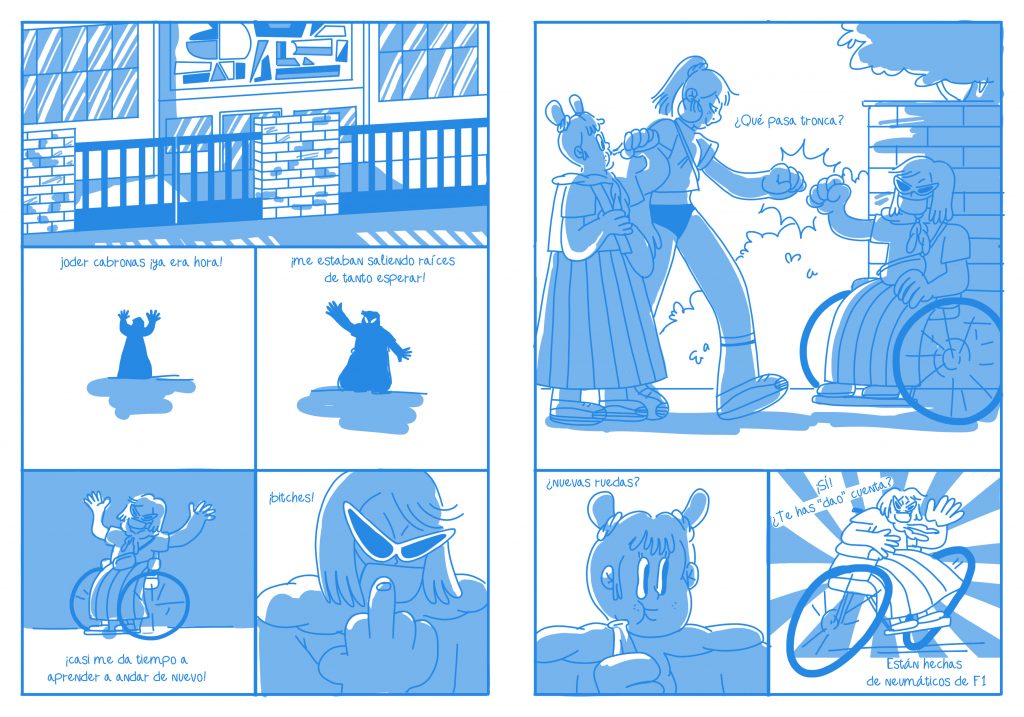
The first thing I noticed about your style is your lines – super wavy, stretchy, balloon-like characters. It seems very fleshy but also very magical at the same time. When did you develop this aesthetic?
I suppose it’s the result of trying to come up with a way to illustrate non-normative bodies. One clear goal of my professional career is that I never want to exclude any genders or body forms in my illustrations, and I guess in my quest to achieve that the bodies I draw have become distorted with time and have turned into some kind of elastic balloons or into “hot-dog bodies” – as I was (very accurately) told once in Twitter.
In any case, I’m very driven by my curiosity, which keeps me wanting to continuously research and reflect on what I do. I also have a lot of ideas about the things I want to experiment with, so my current style might not be the defining one of my career.
I also wanted to touch on your use of color. In your comics, you seem to be more interested in using colors to create an atmosphere, rather than drawing lots of mise-en-scene details.
I’m crazy about color, I think it was one of the courses I enjoyed the most when I was studying Graphic Design, and when I started working for myself I also enjoyed discovering artists and schools that use color as a tool for communication. I think a page can sometimes be overloaded with information, but for my own mental health, I often need to work with bigger spaces that perhaps help me to better communicate what I want.
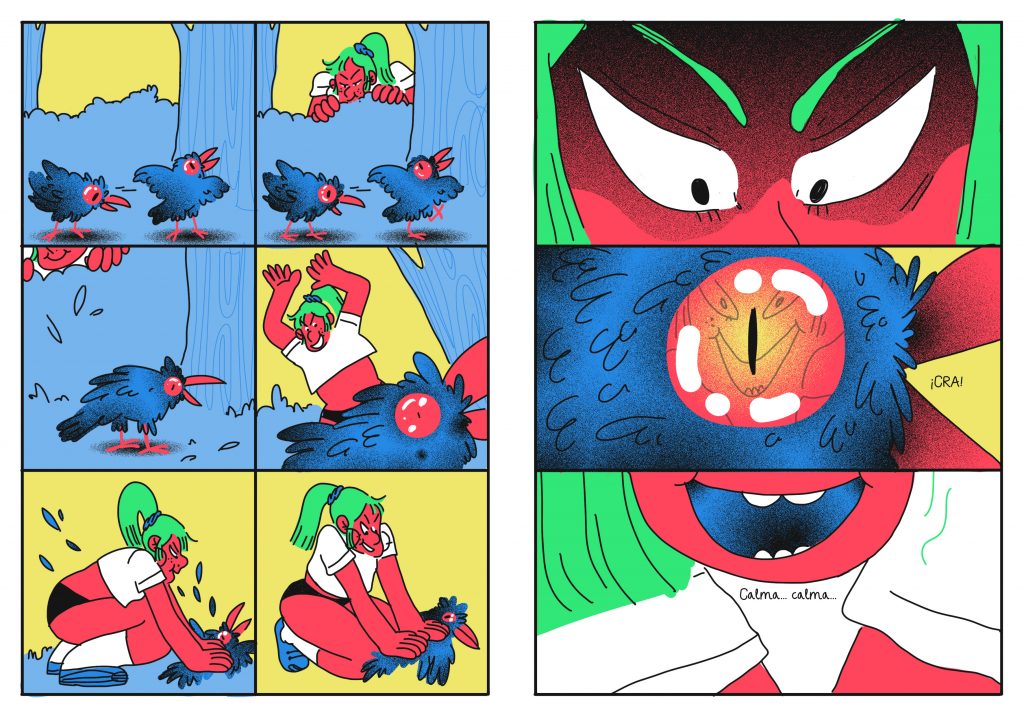
Are your illustrations for zines and clients done digitally?
I usually start by sketching in pencil in a very loose and scruffy way, and then I use my Cintiq or iPad to make the necessary adjustments and changes. I recently made my friends at Jumbo Press a handmade comic and I still can’t believe the amount of time that I spent drawing by pencil and digitizing it (it is going to be printed in riso, which involves separating different layers of color). I can’t wait to see it printed, I’m sure I’ll shed a tear of joy!
On the topic of your murals – how do approach, and what are your aims, when preparing a work for a public space?
I have very recently started exploring working with murals. I had never considered painting in such a big format, but my friends from Hits With Tits gave me the opportunity to do so, and it was so fun that I’m looking forward to making more. It’s a very fresh way to approach a canvas, as it allows you to make errors in an exaggerated way, and the way to correct them is so different. I’m fascinated by the idea of applying this working method to the digital world.
You’ve also produced animations and have also made art for apparel and guitars. Is making your illustrations more multimedia something you’d like to explore?
Yes! Curiosity keeps me alive and active, it keeps me moving forwards. I don’t have plenty of time outside of my professional projects, but I love to make room for those unique and special opportunities that my profession offers. It’s a crazy and rewarding feeling to be a part of these projects. And while dealing with something that you can mess up can be scary, finishing these projects makes me feel crazy happy and want to catch up on my sleep to recover.
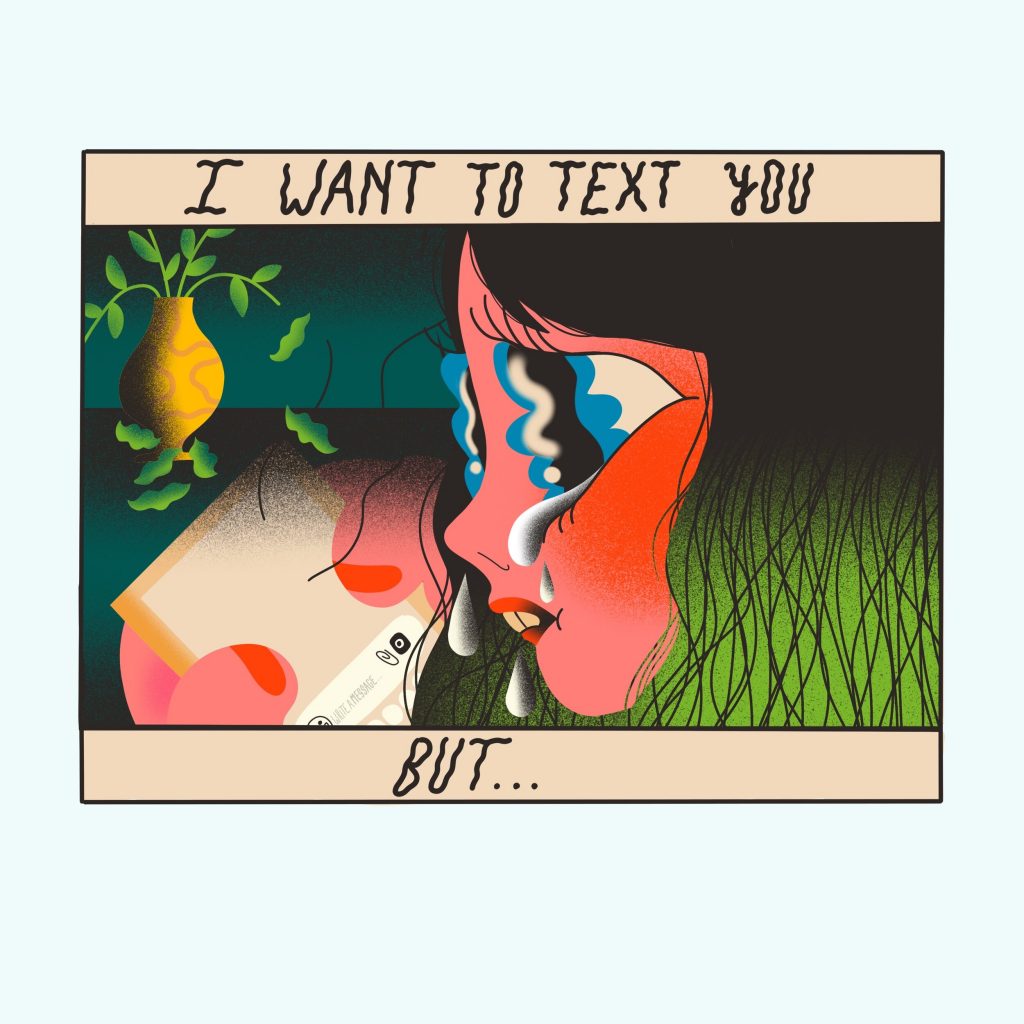
You work as a commercial illustrator. Recent surveys in both the UK and the USA have highlighted that professional illustrators tend to be earning well below the living wage. How do you find fees and treatment from commercial clients who aren’t necessarily in the arts industry?
This is the million-dollar question. Personally, I feel like I’ve been pretty lucky in this regard, although it’s true that for several years I had to keep up with a frenetic work rhythm just to be able to have a decent wage. I’ve worked many long hour days and have sacrificed many weekends and holidays for years, though I wouldn’t say it’s the ideal thing to do. I think us freelancers spend so many hours working, but if we had to tell another person to do our job, we would probably not make them work this hard. I’ve sacrificed a lot, had a lot of back pain, and have missed many laughters with my family and friends to be in the stable position that I find myself in today, but I wish it didn’t have to be this way. Looking back, now that I am more secure economically speaking, I’d say that it was all worth it, though I wished it hadn’t been like this.
The world of clients is a lottery. You can have ones who are in love with your work and allow you to have creative freedom to come up with a really cool project, and those ones who you honestly don’t even know why they’re interested in you, as it’s pretty clear they don’t like what you do. Private clients especially freak out when they see prices, and don’t realize everything that comes into consideration when making a budget. Having said that, there have been very few times when I’ve been in the horrible position of being like “look, kill me, this project is shit and I want to bury it and never have an experience like this in the future”.
You have agency representation – has this helped your prospects, do you think?
Yes – I personally think that having an agent has been very important for my career. Agents have a great ability to reach out to certain clients that might be tricky to contact on a personal level. Also, finding an agent that you get on well with, that is on the same page as you, and understands you, makes being part of a team be such a delight and allows you to relax a bit on certain tasks of being a freelance illustrator.
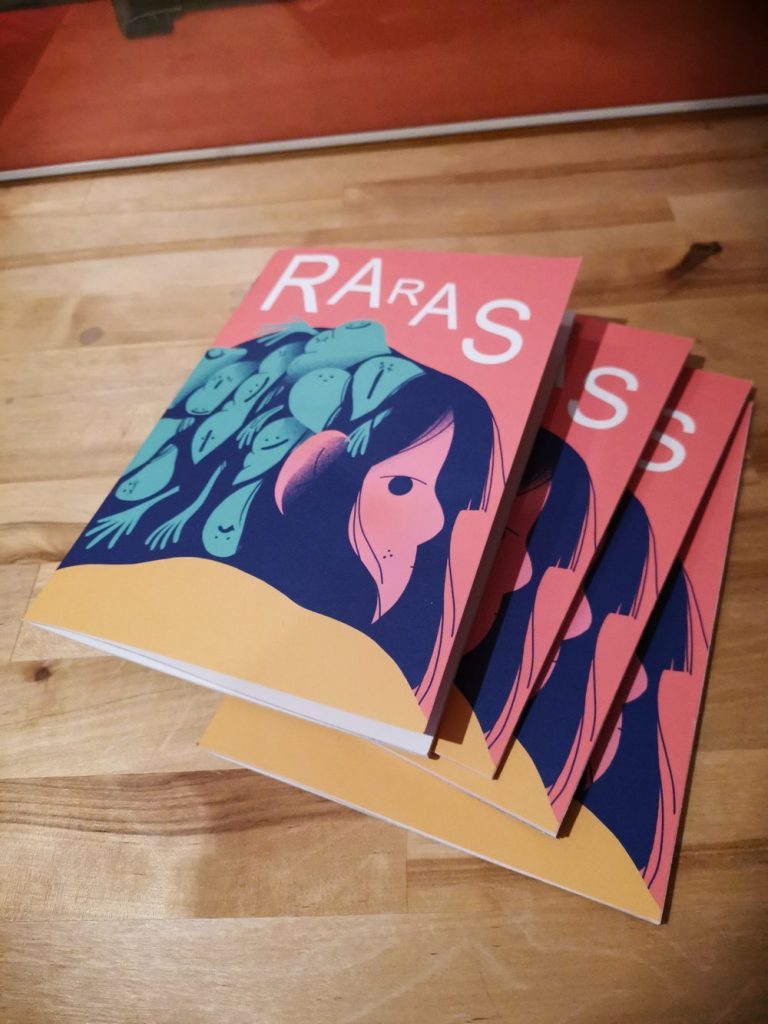
Transitioning from your personal career to your role in the Barcelona/Spanish scene more broadly… can you briefly describe the comics/zine scene you are involved in, from your perspective?
Every time I get to be a part of/go to a zines or comics festival I go back to my studio with so many ideas. It’s so great to see the creative and production capacities of different artists and seeing how far someone that is part of your same artistic collective can go. It lights a flame inside me and makes me feel like thinking and producing a lot of new things. It’s always a rewarding experience, and if on top of that you also get the chance to be with some friends and meet new people that’s a plus. I would recommend everyone to stop by one of these festivals and have a look at what we do.
You started this Raras project a couple of years ago. I imagine it was always planned to be a female-artist only affair. Could you talk about the impetus and the politics behind the project?
Raras is my best project so far. I’m so glad that for that Friday night, when the idea came to my mind, I started stalking my favorite artists. To me, this is a personal fetish project, as I love being able to write “I’m your fan and I want you in Raras”. The feedback was always great and to think that I built a project with artists that I admire is really thrilling.
Raras (meaning “weirdos”) was born out of the personal experience of having been categorized as a weirdo all my life; a weirdo regarding what I read, for liking comics, playing video games, liking horror and zombie movies… It seems like every time I’ve done something that didn’t go with the norm, the first thing I’ve been called is a weirdo. But I decided that being a weirdo didn’t have to be a bad thing. I’ve given total writing and illustration freedom to every female artist that has been part of the project. I want them strong, free, and united so that Raras blows the mind of all curious people.
What was the process behind curating the two issues of Raras? Were you in touch with the contributors already?
I usually make a list of the people I’d like to be involved in the project and send collective emails so that everyone sees who’s in and can decide if they’d like to be a part of something like this. Sometimes I do know the artists but some others I don’t or haven’t, and when they tell me they’d love to participate, that’s when I get that fandom kind of excitement. It makes me so happy and it’s amazing to be able to work with such great minds! It makes the final product have a spectacular quality.
As I’m in charge of this project myself, the process is long and often tiring. I make the economic investment too, and once the project is done I prepare a thank you pack and send it to the artists that have been involved. I don’t think I’ve recovered the investment I made, but I enjoy it so much that I don’t care about that.

In your opinion, what makes artists stand out, both locally and internationally?
I think that being able to have internet access in such an easy way gives us the chance to get to know so many projects that otherwise we would miss. All the free platforms, such as Instagram or Behance, offer an amazing chance to showcase your work. However, one can easily fall into a black hole and minimize your worth in them, so it’s really important to stay out of that to avoid unnecessary comparisons and absurd phantoms. Being involved in your local scene is also very important and has several benefits. I think you have to be willing to get out there (if work allows) and enjoy the opportunities to discover new artists and projects that might influence your perception of your own work.

Leave a Reply